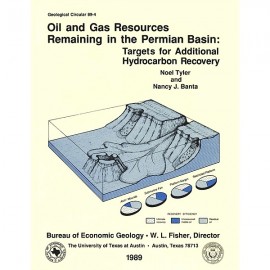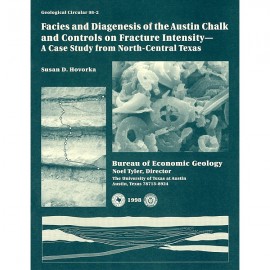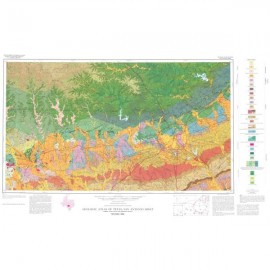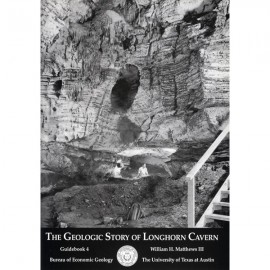Geological Circulars
-
Books & Reports
- Reports of Investigations
- Guidebooks
- Udden Series
- Geological Circulars
- Down To Earth
- Atlases of Major Oil and Gas Reservoirs
- Texas Memorial Museum Publications
- Environmental Geologic Atlas of the Texas Coastal Zone
- Mineral Resource Circulars
- Other Reports
- Seminars and Workshops
- Handbooks
- Submerged Lands of Texas
- Symposia
- Annual Reports
- Open File Reports
-
Maps & Cross Sections
- Thematic Maps
- Miscellaneous Maps, Charts & Sections
- Geologic Atlas of Texas
- STATEMAP Project Maps
- Geologic Quadrangle Maps
- Cross Sections
- Highway Geology Map
- Energy and Mineral Resource Maps
- Shoreline Change and Other Posters
- Wilcox Group, East Texas, Geological / Hydrological Folios
- Bouguer Gravity Atlas of Texas
- River Basin Regional Studies
- Featured Maps
- Posters
- Teachers & the Public
-
Geological Society Publications
- Gulf Coast Association of Geological Societies
- Alabama Geological Society
- Austin Geological Society
- Corpus Christi Geological Society
- Houston Geological Society
- Lafayette Geological Society
- Mississippi Geological Society
- New Orleans Geological Society
- South Texas Geological Society
- GCS SEPM Publications
- Historic BEG & UT Series
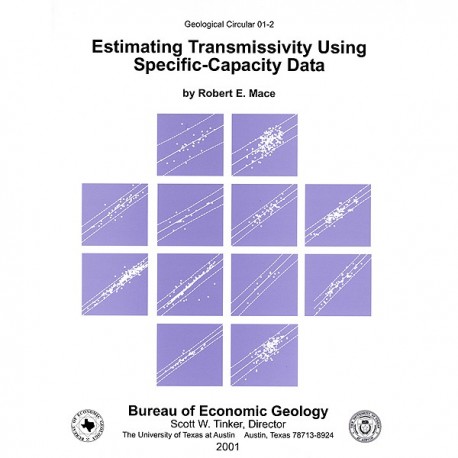
GC0102. Estimating Transmissivity Using Specific-Capacity Data, by R. E. Mace. 44 p., 18 figs., 2 tables, 1 appendix, 2001. Print.
To purchase this publication as a downloadable PDF, please order GC0102D.
About This Publication
This circular categorizes, summarizes, recommends, and provides insights into the different techniques available for relating specific capacity to transmissivity. It comprises work performed for the Edwards Aquifer Authority, the Texas Water Development Board, the Lower Colorado River Authority, and the Texas National Research Laboratory Commission.
ABSTRACT
Because specific-capacity data are useful for estimating transmissivity, they should be used whenever possible in hydrogeologic studies. Including specific-capacity data will increase the number of transmissivity estimates in aquifers, sometimes dramatically, allowing more accurate statistical and spatial descriptions of transmissivity and hydraulic conductivity. Three main approaches are used in estimating transmissivity from specific capacity data: analytical, empirical, and geostatistical. The most commonly used analytical approach is an equation derived from the Theis nonequilibrium formula, which requires corrections for well loss, vertical flow due to partial penetration, and reduced saturated thickness. The empirical approach involves empirically relating transmissivity to specific capacity measured in the same well. This approach commonly requires at least 25 data pairs but does not require a correction for turbulent well loss or vertical flow resulting from partial penetration. Geostatistical techniques are useful for estimating transmissivity from specific capacity, developing interpolated maps of transmissivity, and quantifying the estimation uncertainty. Geostatistical techniques are, however, mathematically complicated and require a substantial number of data to define semivariograms and cross-semivariograms. Techniques for estimating transmissivity from specific-capacity data have been successfully applied in many aquifers in Texas and elsewhere to provide valuable information for inputting to numerical models and for evaluating water resources.
Keywords: aquifer, ground water, hydraulic conductivity, specific capacity, transmissivity
CONTENTS
Abstract
Introduction
Specific Capacity
Analytical Methods
Solutions Based on the Dupuit-Thiem Equation
Solutions Based on the Theis Nonequilibrium Equation
Other Analytical Approaches
Empirical Methods
Statistically Derived Linear Relationships
Published Empirical Relationships
Hybrid Approaches
Geostatistical Methods
Kriging with Linear Regression
Cokriging
Kriging with Transformed Values
Other Geostatistical Approaches
Partial Penetration
Well Loss
Estimating Turbulent Well Loss from Step-Drawdown Tests
Estimating Well Loss from Time-Drawdown Tests
Graphically Estimating Well Loss
Estimating Turbulent Well Loss by Using Empirical Relationships
Estimating Well Loss by Using Pipe-Flow Theory
Incorporating Well-Loss Corrections
Fractured and Karstic Rocks
Data-Quality Issues
Other Issues
Correcting for Decreased Saturated Thickness
Including Tests Having No Reported Pumping Time or Well Radius
Including Tests Having No Measurable Drawdown
Multiple Production Zones
Recommended Approach
Conclusions
Acknowledgments
References
Symbols
Appendix A. Estimating transmissivity from specific-capacity data using the Theis and others equation inside a spreadsheet
Figures
1. Data from a pumping test on a well completed in a confined aquifer
2. Plot showing decrease in specific capacity with increasing time of pumping
3. Time for water levels to stabilize after initiation of pumping as a function of transrnissivity and storativity
4. Relationship between transmissivity and specific capacity for alluvial and fractured hard-rock aquifers using Thomasson and others approach
5. Sensitivity of specific capacity to variation in transmissivity and a parameter, C', that incorporates effects of pumping time, well radius, and storativity
6. Example of an empirical relationship between transrnissivity and specific capacity for a karstic aquifer in Texas showing the best-fit line and the 95-percent prediction intervals for the linear fit and the best-fit lines for second- and third-order polynomials
7. Empirical relationships between transmissivity and specific capacity
8. Comparison among different empirical relationships and between empirical relationships and analytical approaches
9. Relationship between measured specific capacity and pumping rate in the Edwards aquifer
10. Effect of well loss on specific capacity for dimensionless well loss, where II = CQB-1and Rscis specific capacity corrected for well loss divided by the measured specific capacity
11. Determining B and C from step-drawdown tests, an example of estimating B and C from a step-drawdown test, and sensitivity to n for a constant B and C
12. Plot to estimate well loss from discharge rate
13. Relationship between specific capacity and well-loss constant, showing the best-fit line and 95-percent prediction intervals
14. Comparison between measured well loss and well loss estimated from an empirical relationship between specific capacity and well-loss constant and pipe-flow theory
15. Production rates for specific-capacity tests in the Edwards aquifer where there was no measurable drawdown
16. The minimum production rate required to produce at least 1 ft of drawdown for a given transrnissivity, assuming a production time of 8 h, a well radius of 4 inches, and a storativity of 10-4
17. Empirical relationship between transrnissivity and specific capacity for the Carrizo-Wilcox aquifer of east-central Texas
18. Error comparison between the empirical approach and the analytical approach to estimating transmissivity from specific capacity in the Carrizo-Wilcox aquifer of east-central Texas
Tables
1. Summary of empirical relationships between specific capacity and transmissivity
A-1. Example spreadsheet for calculating the Theis and others equation
Citation
Mace, R. E., 2001, Estimating Transmissivity Using Specific-Capacity Data: The University of Texas at Austin, Bureau of Economic Geology, Geological Circular 01-2, 44 p.

